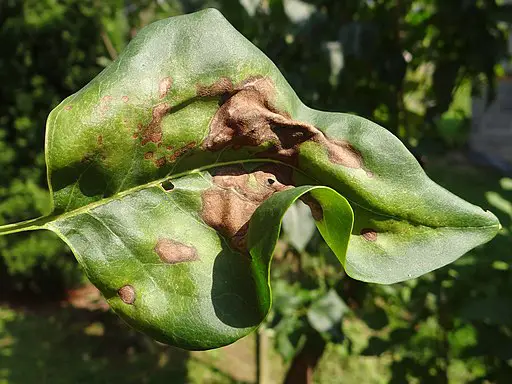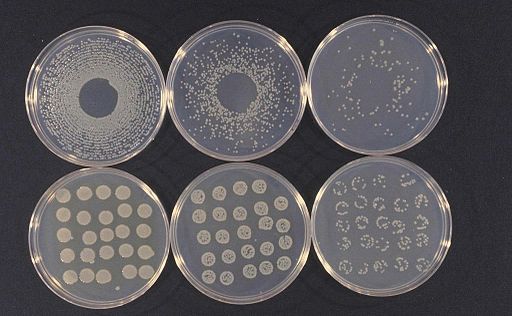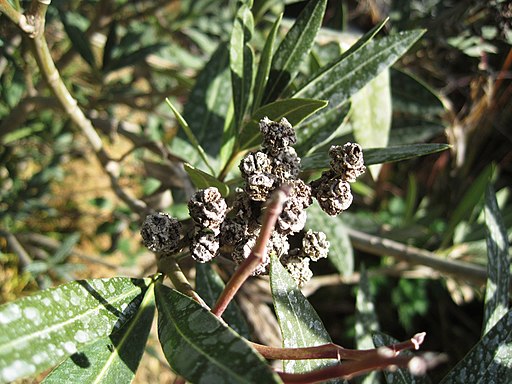Pseudomonas syringae
Classification, Characteristics and Disease
Classification
A member of the genus Pseudomonas, Pseudomonas syringae is classified as follows:
· Kingdom: Bacteria - As a member of the kingdom (or domain) bacteria, Pseudomonas syringae is a prokaryote and thus lacks membrane-bound organelles. However, it possesses plasmid DNA, ribosome as well as a cell wall (components associated with the majority of bacteria)
· Phylum: Proteobacteria - The phylum Proteobacteria is a large group that consists of a wide variety of some of the most common Gram-negative pathogens. Although some of the species are not motile, the majority of species like Pseudomonas syringae have polar flagella and are also characterized by lipopolysaccharides on their outer membrane.
· Class: Gammaproteobacteria - Like Pseudomonas syringae, members of the class Gammaproteobacteria are Gram-negative rods (the majority of species have a rod-like shape) that are ubiquitous in nature. The majority of species move by means of polar flagella (or a single flagellum) and capable of infecting animals or plants.
· Order: Pseudomonadales - Members of this group are Gram-negative bacteria that move by means of flagella. Although the majority of species are free-living organisms, some of the species are also opportunistic pathogens that can causes diseases.
· Family: Pseudomonadaceae - Members of this family are strict aerobes that move by means of polar flagella/flagellum. They are also Gram-negative rods most of which are free-living or have formed a relationship with various insects. However, some of the species are opportunistic pathogens.
· Genus: Pseudomonas - Pseudomonas is a group of Gram-negative bacteria that are highly diverse and widely distributed in nature. They are mostly free-living organisms that possess a single or several polar flagella and a few species can cause diseases in animals or plants.
· Species: Pseudomonas syringae - Characteristics of this species are discussed below in detail.
Characteristics of Pseudomonas syringae
Morphology and Structure
Like many other members of the genus Pseudomonas, Pseudomonas syringae is a rod-shaped bacteria (some cells may appear to be slightly curved).
With regards to size, the average length of the bacteria is about 1.25um with the thickness ranging from 0.5 to about 0.8um.
The following are some of the structural characteristics of Pseudomonas syringae:
Flagella - Like many other Pseudomonas bacteria, Pseudomonas syringae move by means of polar flagella. In culture, this structure is important for swarming motility where the bacteria can effectively spread on the surface of the media to access nutrients. This reduces competition as newly produced cells continue spreading to the edge of the colony.
For mutant P. syringae that lack a flagellum (non-motile), studies have shown them to be more sensitive to UV light and desiccation when compared to motile ones. Moreover, compared to motile Pseudomonas syringae, non-motile Pseudomonas syringae are unable to effectively invade plant leaves and cause disease.
Pili - In addition to the polar flagellum, Pseudomonas syringae also have pili on their surface (chaperone-usher fimbrial and type IV pili). Depending on the cell, these structures may range between 6 and 8 nanometers in diameter but may extend several micrometers in length. However, they are shorter and thinner when compared to the flagellum.
Some of the main functions of pili include adhesion, biofilm formation, as well as invasion. However, like flagella, they also promote motility and promote movement of the bacteria on plant surfaces.
Cell envelope - Being a Gram-negative bacteria, Pseudomonas syringae has an outer membrane, a cell wall (which consists of a peptidoglycan layer), as well as an inner membrane. The outermost membrane (OM) consists of lipids, proteins, and lipopolysaccharides among other molecules.
During growth, studies have also shown the bacteria to release outer membrane vesicles (nanosized proteoliposomes) which consist of the molecules mentioned above and are involved in host-bacteria interaction.
The vesicle is also associated with a number of substances including phytotoxin and coronatine and therefore has a role to play in the pathogenicity of the organism.
The cell wall is located between the inner and outer membrane and consists of a single peptidoglycan layer. The inner membrane is similar to the cell membrane of eukaryotic cells and consists of a phospholipid bilayer.
Ecology and Distribution
Pseudomonas syringae is commonly found living on the surface of different types of plants as an epiphyte. Because the bacteria can be found on the surface of different types of plants (monocots, woody dicots, and herbaceous dicots), it's widely distributed and can be found in different parts of the world.
Currently, over 60 pathovars of Pseudomonas syringae have been isolated based on host range among other properties. This genetic diversity has allowed the bacterium to adapt to different environments thus contributing to its wide distribution.
Apart from plant surfaces/phyllosphere (leaves, stem, flowers etc), Pseudomonas syringae can also be found in such ecological niches as alpine lakes and streams, epilithic biofilms, and precipitation.
While the bacteria tends to proliferate in dry and hot environmental conditions, wet conditions and rainy conditions are essential in that they allow the bacteria to be transported from one plant host to another.
Metabolism
Pseudomonas syringae is a chemoheterotrophic organism and thus relies on a host for its nutrition. All the pathovars are aerobes and use aerobic metabolism for energy production. As such, they need oxygen to break down organic matter for energy production.
As mentioned, the bacteria is nutritionally versatile. Given that it can be found on the surface of a wide variety of plants, it's able to access the material required for survival.
Apart from tissue and other organic material on the surface of these plants, the bacteria also obtains its nutrition from dead and decaying organic material, especially during unfavorable conditions. As such, they can exist as saprophytes under certain environmental conditions.
While it can survive on the plant surface as an epiphyte, Pseudomonas syringae lives a parasitic lifestyle when it invades the apoplast through such openings as the stomata or through wounds on the plant surface.
Colonization of the apoplast allows the bacteria to obtain the nutrition it needs for survival but also results in plant diseases.
Reproduction
Like many other bacteria, Pseudomonas syringae reproduce through a process known as binary fission. This is a form of asexual reproduction where a single cell (the parent cell) divides to produce two identical daughter cells that are capable of growing, maturing, and continuing the reproduction cycle.
Unlike mitosis, this process of cell division occurs in prokaryotes and serves as a means of asexual reproduction rather than growth.
Disease
In order to understand diseases caused by Pseudomonas syringae and how these diseases occur, it's important to understand the life cycle of the bacterium. In its epithytic phase, Pseudomonas syringae lives on the surface of the plant/phyllosphere (of leaves, stem, and flowers, etc).
Here, the bacteria survive by breaking down organic material on the surface of the plant (e.g. damaged plant tissue on the plant surface etc).
Using polar flagella and pili (Type IV pili has been associated with chemotaxis), the bacterium enters the plant tissue through wounds on the surface of the plant as well as natural openings such as the stomata. This is known as the endophytic phase of the bacterium and often occurs when there is a high number of the organism on the plant surface.
* Although Pseudomonas syringae mostly cause disease by transforming from the epiphytic phase to the endophytic phase (entry into plant tissue and consequently multiplying within the apoplast), studies have shown that this is not a simple process, and most microorganisms are unable to do this successively.
This is largely due to the fact that most plants have developed defense mechanisms aimed at reducing pathogen entry.
In the case of Pseudomonas syringae, however, such virulence factors as phytotoxin coronatine and T3E counter these defenses and promote entry.
Once the bacterium gains entry into the plant tissue, it still has to invade the apoplast where it can grow and reproduce. To overcome immune responses in this environment, the organism may produce various virulence factors that counter these defenses.
For instance, through the production of coronatine, the bacterium activates a protein that inactivates immune regulators in the mesophyll layer.
See leaf structure under the microscope.
Following a successful entry, the bacterium causes diseases in the following mechanisms:
Ice nucleation and frost injury
Along with a few other bacterial species, Pseudomonas syringae is one of the bacteria capable of nucleating supercooled water to form ice. As such, it may be classified as an ice nucleation active bacteria (ICA Bacteria).
It's worth noting that water only supercools, but does not freeze at 0 degrees C. However, the Pseudomonas syringae produces a protein known as InaZ protein that can arrange water molecules into a formation that can form ice (from the supercooled water).
In addition to arranging the molecules in a manner that produces ice, the protein also promotes the release of heat from the water as it freezes thus enhancing the freezing process to create ice.
Within plant tissues (as well as on the surface of plants), this process results in the formation of ice crystals (in and out of the leaf, etc) which in turn causes frost injury to the plant.
* In the presence of Pseudomonas syringae, water molecules can freeze at between -2 and -10 degrees C.
The formation of ice in the plant tissue causes injury to the plant cell. As a result, in plants like wheat, ice formation and thus cell damage, may have a number of effects including discoloration, damage to the stems, and floret sterility, etc. This has a direct impact on yields.
Toxins
Like some of the other Pseudomonas, Pseudomonas syringae produce toxins that result in disease development. The toxins produced by this particular bacterium are known as phytotoxins and include coronatine, tabtoxin, syringopeptin, phaseolotoxin, and syringomycin.
Although there are a number of these toxins, they can be divided into two main groups including; phytotoxins that cause chlorosis (Phaseolotoxin, tabtoxin, and coronatine) and those that cause necrosis (syringopeptin and syringomycin).
Generally, phytotoxins that cause chlorosis act by inhibiting the enzymes involved in the biosynthesis of amino acids in the urea cycle. For instance in addition to competing for carbamoyl phosphate-binding site of ornithine carbamoyltransferase (an important enzyme in the urea cycle involved in the conversion of carbamoyl phosphate and ornithine to citrulline), the phytotoxin also binds to the enzyme-carbamoyl phosphate complex (involved in the production of carbamoyl phosphate).
By competing for binding sites of these enzymes, these toxins affect important biological processes and ultimately result in chlorosis. For the most part, syringomycin and syringopeptin are produced by pathovar syringae.
Unlike the other toxins, these toxins represent the second class of lipodepsipeptide phytotoxins and function by producing cytotoxic pores on the plasma membrane that ultimately cause necrosis.
Degrading enzymes
In addition to the toxins, pseudomonas syringae also produces enzymes capable of degrading plant tissue thus causing disease. Here, one of the best examples includes pectolytic enzymes.
Such enzymes as glycoside hydrolases can degrade cellulose and pectate matrices which not only affect the cellular functions but also damage plants.
In a scenario where the bacterium population is significantly high (on the surface of the plant), the production of these enzymes also contributes to tissue damage. Following successful invasion (entry into the tissue), degradation activities of these enzymes result in continued tissue damage which in turn results in such symptoms as blossom-end rot.
Some of the diseases caused by Pseudomonas syringae include:
Bacterial Canker - Bacterial canker is a disease of the leaves and stems that affects a number of plants/crops including peaches, stone fruit trees, cherries, and plums, etc. It's characterized by depressed and darkened areas that become increasingly dark over time.
In addition, the affected area produces a gummy substance that contributes to the destruction and death of both the stem and the plant. During rainy seasons, the bacterium is easily spread from the infected plants to other plants which can cause significant loss through reduced yields.
Bacterial blight of coffee - This disease is caused by the pathover Pseudomonas syringae pv. garcae and is common in parts of Kenya and Brazil. It's characterized by lesions on the leaf which gradually become darker as they expand and spread.
Infected leaves also become necrotic as they curl inwards. Apart from the leaves, the buds are also affected which affects their development. As the disease develops, studies have shown the vascular tissue to also be damaged which is characterized by the darkening of the branch before it wilts and dies.
Treatment
Treatment of these diseases (caused by Pseudomonas syringae) involves the use of chemical and biological agents that either destroy the pathogen or activate the defense system of the plant.
Some of the chemical compounds that have been successfully used for treatment include copper compounds such as copper hydroxide and antibiotics such as streptomycin. These compounds can also be used in combination with other fungicides.
Here, spraying these chemical compounds helps reduce the pathogen from spreading thus protecting some of the plants/crops. However, this has also been shown to reduce yields.
Bacteriology as a field of study
Bacterial Transformation, Conjugation
How do Bacteria cause Disease?
Bacteria - Size, Shape and Arrangement - Eubacteria
Return to Pseudomonas main page
Return to Pseudomonas fluorescens
Return to learning about Pseudomonas aeruginosa
Return from Pseudomonas syringae to MicroscopeMaster home
References
Alessandro Passera et al. (2019). Not Just a Pathogen? Description of a Plant-Beneficial Pseudomonas syringae Strain.
Christopher R. Clarke et al. (2016). Comparative genomics of Pseudomonas syringae pathovar tomato reveals novel chemotaxis pathways associated with motility and plant pathogenicity.
Chiranjit Chowdhury and Medicharla Venkata Jagannadham. (2012). Virulence factors are released in association with outer membrane vesicles of Pseudomonas syringae pv. tomato T1 during normal growth.
Eva Arrebola, Francisco M. Cazorla, Alejandro Perez-García and Antonio de Vicente. (2011). Chemical and Metabolic Aspects of Antimetabolite Toxins Produced by Pseudomonas syringae Pathovars.
Juan-Luis Ramos, Johanna B. Goldberg, and Alain Filloux. (2014). Pseudomonas: Volume 7: New Aspects of Pseudomonas Biology.
Xiu-Fang Xin, Brian Kvitko & Sheng Yang He. (2018). Pseudomonas syringae: what it takes to be a pathogen.
Links
Find out how to advertise on MicroscopeMaster!







